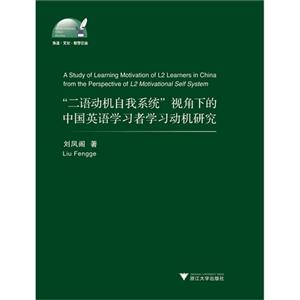二语动机自我系统视角下的中国英语学习者学习动机研究
本书特色
[
首先在对目前*新的二语动机理论——“二语动机自我系统”理论在中国学习者中的效度进行了探讨,然后在中国英语学习者中做了实证调查和实验研究。实证调查研究发现,在二语动机自我系统要素对二语学习动机贡献强度与学习者的二语水平密切相关。本研究结果对“二语动机自我系统”理论有局部拓展,并具有一定教学启示。实验研究发现基于提升“二语自我”为核心的教学干预对二语学习动机及二语成绩有显著影响。
]
内容简介
[
首先在对目前*新的二语动机理论——“二语动机自我系统”理论在中国学习者中的效度进行了探讨,然后在中国英语学习者中做了实证调查和实验研究。实证调查研究发现,在二语动机自我系统要素对二语学习动机贡献强度与学习者的二语水平密切相关。本研究结果对“二语动机自我系统”理论有局部拓展,并具有一定教学启示。实验研究发现基于提升“二语自我”为核心的教学干预对二语学习动机及二语成绩有显著影响。
]
目录
chapter 1 introduction 1.1 the complex nature of l2 motivation 1.2 theoretical framework for the present research: a new proposalabout l2 motivation–l2mss 1.3 the necessity of studying l2 motivation of learners of englishin china from the perspective of l2mss 1.4 objectives of the present study 1.5 outline of the bookchapter 2 literature review of l2 motivational study 2.1 the social psychological period (1959–1990) 2.2 the cognitive-situated period (during the 1990s) 2.3 the process-oriented period (2000–2004) 2.4 dornyei’s l2mss model and the new l2 motivation study period(2005– ) 2.4.1 background in which l2mss was proposed 2.4.2 theoretical foundations of l2mss 2.4.3 the main contents of l2mss 2.4.4 theoretical validation of l2mss 2.4.5 empirical validation of l2mss 2.5 il2s/ol2s versus other similar concepts 2.5.1 il2s/ol2s versus the traditional self concept 2.5.2 il2s/ol2s versus goals 2.5.3 il2s/ol2s versus empty dreams or fantasies 2.6 a brief review of l2 motivation research in china 2.7 summarychapter 3 research methods of the survey study 3.1 research purposes 3.2 research questions 3.3 hypotheses 3.4 theoretical model 3.5 research design 3.6 development of research instruments 3.6.1 procedure of developing the questionnaires 3.6.2 results of the pilot studies 3.6.3 final versions of the instruments 3.7 participants 3.8 data collection 3.9 data analysis techniques and procedure 3.10 instrument item quality test 3.11 reliability of the instruments 3.11.1 checking internal consistency by referring to cronbach’salpha 3.11.2 checking internal consistency by referring to theitem-total correlation. 3.12 validity of the instruments 3.13 summarychapter 4 results and discussions of the survey study 4.1 results of the descriptive statistics and the normaldistribution test 4.1.1 descriptive statistics 4.1.2 normal distribution test 4.2 integrativeness, il2s and their relationships with l2m. 4.3 distinction between ipro and ipre 4.4 best predictors ofl2mamong l2mss components 4.5 the empirical validation of l2mss among learners of english inchina 4.6 the pattern shown through the parameters of the tripartitecomponents of l2mss across various groups of students at different l2proficiency levels 4.7 rechecking the conclusion of section 4.6 based on the datafrom high-, mid-, and low-level l2 proficiency sub-groups 4.8 summary and pedagogical implicationschapter 5 impact of the l2 self-based interventional treatment onl2 motivation and l2 achievements: a quasi-experimental study 5.1 the necessity of self-based l2 motivation intervention 5.2 literature review of self-based motivation intervention 5.2.1 domyei’s application of ideal/ought-to self in l2 motivationstudy 5.2.2 hock et al.’s possible selves program 5.3 research questions 5.4 research design 5.5 participants 5.6 experimental treatment 5.7 data collection instruments 5.7.1 college entrance english examinations 5.7.2 l2 motivational self questionnaire 5.7.3 final english scores at the end of the semester 5.7.4 delayed l2 proficiency posttest 5.7.5 class observation 5.7.6 interview 5.8 data collection procedure 5.9 data analysis techniques and procedure 5.10 reliability and construct validity of the l2msq (pretest& posttest) 5.10.1 reliability of the l2msq 5.10.2 construct validity of the l2msq 5.10.3 correlational relationships between l2mand classroomobservation 5.11 results of the quasi-experiment and discussions 5.11.1 results and discussions of the data analysis (i): pretestof l2 proficiency pretest and the l2msq variables; normaldistribution check & the descriptive statistics of the l2msq 5.11.2 results and discussions of the data analysis (ii): answerto research question one 5.11.3 results and discussions of the data analysis (iii): answerto research question two 5.11.4 results and discussions of the data analysis (iv): answerto research question three and question four 5.11.5 results and discussions of the data analysis (v): answer toresearch question five 5.12 summarychapter 6 conclusion 6.1 summary of the present research 6.2 major findings 6.3 contributions 6.4 limitations 6.5 suggestions for future research bibliography appendices appendix 3.1 english learner questionnaire for undergraduates andpostgraduates (elqup) appendix 3.2 英语学习者(大学)问卷调查 appendix 3.3 english learner questionnaire for primary and middleschool students (elqpm) appendix 3.4 英语学习者(中小学)问卷调查 appendix 5.1 road map for my ideal l2 self appendix 5.2 l2 motivational self questionnaire (l2msq) appendix 5.3 英语学习问卷调查 appendix 5.4 classroom observation rating scale appendix 5.5 semi-structured interview questions indexes subject index author index 后记
封面

书名:二语动机自我系统视角下的中国英语学习者学习动机研究
作者:刘凤阁
页数:183
定价:¥35.0
出版社:浙江大学出版社
出版日期:2013-04-01
ISBN:9787308113090
PDF电子书大小:99MB 高清扫描完整版
